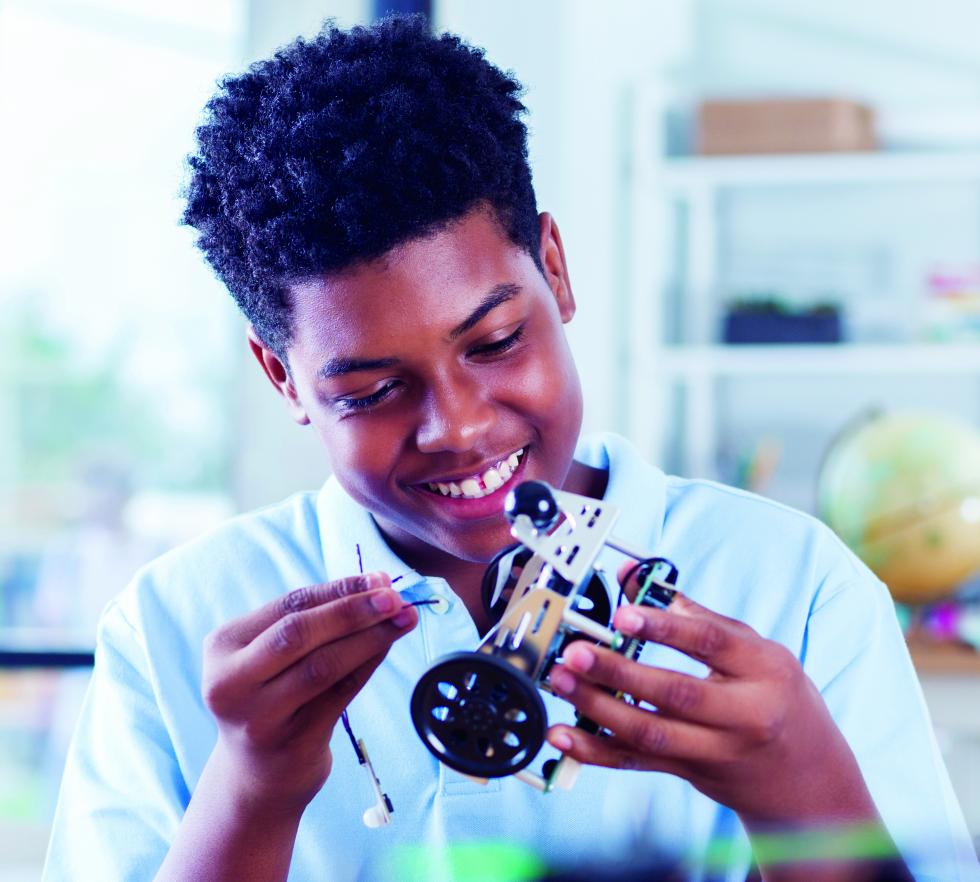Middle Grades STEM Curriculum
Building pathways to emerging tech careers
 STEM skills are essential in the workplace of today and tomorrow. To succeed, students need to be able to grasp complex problems, think creatively, understand technology and troubleshoot problems.
STEM skills are essential in the workplace of today and tomorrow. To succeed, students need to be able to grasp complex problems, think creatively, understand technology and troubleshoot problems.
SREB’s middle grades STEM projects awaken students’ natural curiosity about the world and deepen their understanding of scientific inquiry and the engineering design process — all while introducing them to exciting, tech-driven careers.
Our Project-Based Approach to STEM Exploration
Project-based learning cultivates essential critical thinking, problem-solving and teamwork skills. In middle grades STEM projects, students work with peers to apply STEM skills to solve real-world problems in fields like these:
Middle Grades STEM Projects
- Project 1: Bridging the Gap – Students become civil engineers as they design a new bike path bridge to cross a stream that accommodates two bicycle lanes and emergency vehicles. Students explore types of bridges, static forces and scale factors in drawing and model-building.
- Project 2: Reverse Engineering – Students become packaging designers as they reverse engineer existing package designs to use flatstock material and be more environmentally friendly. Students explore material properties, volume, surface area and mathematical nets.
- Project 3: Rapid Prototyping – Students design a commemorative coin for the U.S. Mint that highlights a social or historical event. Students use rapid prototyping to test their designs and explore how density, mass, and volume can help to determine the dimensions of their designs.
- Project 4: Coding for Fun – Students become game designers as they develop a game concept targeted to middle grades students. Students learn the basics of coding, developing surveys and analyzing survey data to improve their games.
- Project 5: Harness the Wind – Students become research company workers as they develop improved blades for wind turbines used in different geographic areas. Students explore drag and lift as they design their blades and experiment with independent and dependent variables.
- Project 6: Sound the Alarm – Students become local council representatives working to improve their community’s emergency preparedness plan. Students learn about the logistics of procuring supplies, evacuating people and creating and using maps.
- Project 7: Take a Tour – Students Chamber of Commerce interns as they develop online story maps to attract attention to their city. Students explore geographic information system (GIS) and map tools as they display and analyze bivariate survey data and improve their designs.
- Project 8: Product Creation – Students become food science company workers looking to market healthier snacks foods to young people. Students investigate safe food preparation, the role of macro- and micronutrients, and how to use proportions and ratios to calculate nutrients.
- Project 9: Outbreak – Students become Center for Disease Control investigators researching a suspected disease outbreak. Students develop a disease containment plan by exploring existing containment procedures, mathematical growth models and testing procedures.
- Project 10: Grow a Better Plant – Students become plant scientists for a mustard company looking to design a better plant for their product. Students develop procedures for growing and cross-pollinating plants to maximize desired traits and collect, analyze and present data.
Students also build critical literacy skills while conducting research, preparing written designs and reports, and presenting their findings. All projects are designed to prepare students for challenging STEM programs in high school like SREB’s Advanced Career pathways.
Customizable Design and Delivery
Schools can offer the curriculum as two courses or embed individual projects in other core courses or electives. Schools may also choose to adopt Middle Grades STEM projects as part of SREB’s school improvement framework for the middle grades.
Professional development introduces middle grades STEM teachers to SREB’s approach to project-based learning. Follow-up training and coaching strengthens teachers’ capacity to deliver the projects, foster student ownership of learning and sustain deep inquiry.

